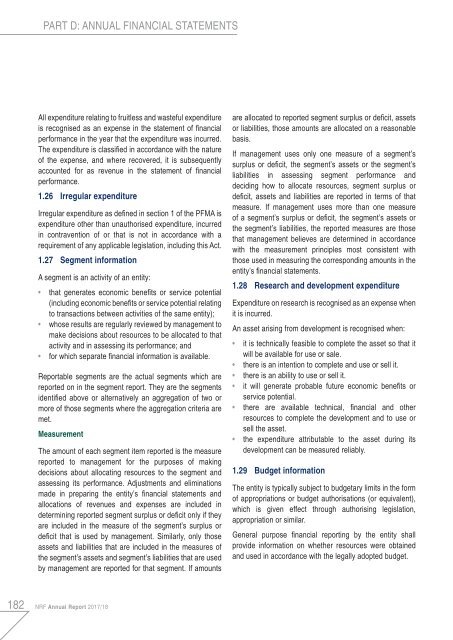NRF Annual Report 2018
You also want an ePaper? Increase the reach of your titles
YUMPU automatically turns print PDFs into web optimized ePapers that Google loves.
PART D: ANNUAL FINANCIAL STATEMENTS<br />
All expenditure relating to fruitless and wasteful expenditure<br />
is recognised as an expense in the statement of financial<br />
performance in the year that the expenditure was incurred.<br />
The expenditure is classified in accordance with the nature<br />
of the expense, and where recovered, it is subsequently<br />
accounted for as revenue in the statement of financial<br />
performance.<br />
1.26 Irregular expenditure<br />
Irregular expenditure as defined in section 1 of the PFMA is<br />
expenditure other than unauthorised expenditure, incurred<br />
in contravention of or that is not in accordance with a<br />
requirement of any applicable legislation, including this Act.<br />
1.27 Segment information<br />
A segment is an activity of an entity:<br />
• that generates economic benefits or service potential<br />
(including economic benefits or service potential relating<br />
to transactions between activities of the same entity);<br />
• whose results are regularly reviewed by management to<br />
make decisions about resources to be allocated to that<br />
activity and in assessing its performance; and<br />
• for which separate financial information is available.<br />
<strong>Report</strong>able segments are the actual segments which are<br />
reported on in the segment report. They are the segments<br />
identified above or alternatively an aggregation of two or<br />
more of those segments where the aggregation criteria are<br />
met.<br />
Measurement<br />
The amount of each segment item reported is the measure<br />
reported to management for the purposes of making<br />
decisions about allocating resources to the segment and<br />
assessing its performance. Adjustments and eliminations<br />
made in preparing the entity’s financial statements and<br />
allocations of revenues and expenses are included in<br />
determining reported segment surplus or deficit only if they<br />
are included in the measure of the segment’s surplus or<br />
deficit that is used by management. Similarly, only those<br />
assets and liabilities that are included in the measures of<br />
the segment’s assets and segment’s liabilities that are used<br />
by management are reported for that segment. If amounts<br />
are allocated to reported segment surplus or deficit, assets<br />
or liabilities, those amounts are allocated on a reasonable<br />
basis.<br />
If management uses only one measure of a segment’s<br />
surplus or deficit, the segment’s assets or the segment’s<br />
liabilities in assessing segment performance and<br />
deciding how to allocate resources, segment surplus or<br />
deficit, assets and liabilities are reported in terms of that<br />
measure. If management uses more than one measure<br />
of a segment’s surplus or deficit, the segment’s assets or<br />
the segment’s liabilities, the reported measures are those<br />
that management believes are determined in accordance<br />
with the measurement principles most consistent with<br />
those used in measuring the corresponding amounts in the<br />
entity’s financial statements.<br />
1.28 Research and development expenditure<br />
Expenditure on research is recognised as an expense when<br />
it is incurred.<br />
An asset arising from development is recognised when:<br />
• it is technically feasible to complete the asset so that it<br />
will be available for use or sale.<br />
• there is an intention to complete and use or sell it.<br />
• there is an ability to use or sell it.<br />
• it will generate probable future economic benefits or<br />
service potential.<br />
• there are available technical, financial and other<br />
resources to complete the development and to use or<br />
sell the asset.<br />
• the expenditure attributable to the asset during its<br />
development can be measured reliably.<br />
1.29 Budget information<br />
The entity is typically subject to budgetary limits in the form<br />
of appropriations or budget authorisations (or equivalent),<br />
which is given effect through authorising legislation,<br />
appropriation or similar.<br />
General purpose financial reporting by the entity shall<br />
provide information on whether resources were obtained<br />
and used in accordance with the legally adopted budget.<br />
182<br />
<strong>NRF</strong> <strong>Annual</strong> <strong>Report</strong> 2017/18


